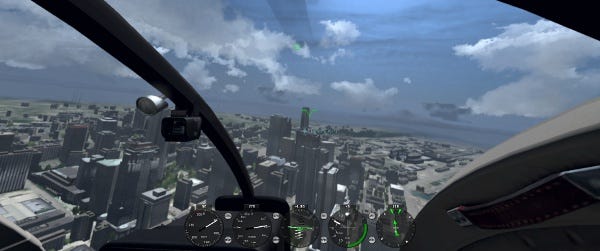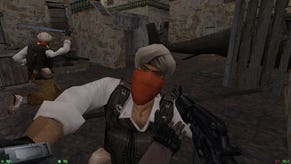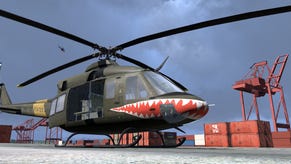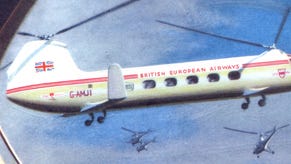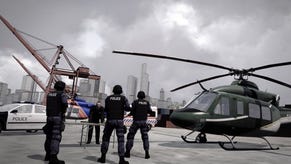Wot I Think: Take On Helicopters
Seattle helicopter royalty
Start with the odd name: Take on Helicopters. At once a warning and an invitation, it sounds at first like a bad translation. After a few hours at the controls of its rotary-winged menagerie, the title ceases to sound strange and becomes a fairly accurate invitation. It asks, can you Take on Helicopters? Here's wot I think.
Helicopters. They are a formidable challenge. I don't think I ever really appreciated how strange they were until this game, despite having flown a great many digital Apaches in the 1990s, when there was a new Apache game roughly ever year.
ToH's helicopters do not fly so much as they dangle from the sky, suspended as if by wires on a handful of slender variables, all anchored to the laws of physics. Nothing is simple here; there is no thoughtless action. Everything is connected. The pitch of the rotor blades affects lift, but lift is also a function of airspeed, which is itself a product of the angle of the rotor disc and, once again, the angle of the blades. Understanding and using these relationships, with ever more finesse and precision, is what ToH attempts to teach.

It can be daunting, but still you are encouraged to Take on Helicopters! The campaign follows an easy learning curve across several missions, and if they court tedium at times, they are at least more interesting and enjoyable thanks to the curious family drama at the heart of this flight sim. You play Tom Larkin, the young scion of Seattle helicopter royalty (!), who has returned home in the wake of his father's death and brother's accident to help save the family business. Each mission gives him some new task, or forces him to fly with greater skill and finesse, so that you grow as a pilot alongside Tom. There are training missions, but the campaign is really the easiest, most entertaining way to learn by doing.
Sincerity and absurdity live side-by-side in this civil-aviation Cinderella Man, where Tom has to dig deep and fly the best six waypoint flight plan ever in order to save his family. A villain oozes onto the stage, the head of an international conglomerate involved in trade and military contracting, and he does everything short of strangling a puppy in order to make clear that he is not to be trusted. Naturally, the elder brother immediately sells him the family business.

All of this is rather endearingly told through the ArmA II engine, with character animations that make Deus Ex look graceful. After dropping my passenger, the sinister Vrana Corp. executive, at his private airport, he went sprinting into his compound like a character in a Wes Anderson movie.
As awkward as it is, there is something compelling about this storyline. Tom Larkin is not a hotshot pilot, but a dutiful son and brother who is working for a family business to which he sometimes seems indifferent. He's fighting for his dad's legacy and his brother's dreams, and along the way he has to run missions for the very rich and their sycophants. I find myself wondering where this story will ultimately lead him. Will he embrace the business and the life prepared for him as a Larkin? Will he get sucked into mercenary work in South Asia? Will he save the business and walk away? The stakes are small, and the story awkwardly told, but it's relatable.
Take on Helicopters is not all aerial chauffeuring. From time to time, Joe Larkin opens up about his time in the army, flying combat missions in South Asia. This leads to flashback combat missions. You won't confuse these choppers with Apaches, but you'll still get plenty of chances to put a brace of Hydra missiles through some poor bastard's windscreen, or lazily orbit a squad of enemy infantry while listening to your door gunners chew them to pieces with miniguns.
One really superb mission occurs fairly early in the game: a routine mission goes badly awry when your helicopter is ambushed, and you have to make a quick emergency landing. The helicopter is pitching and bucking wildly while the rotor blades turn ever more slowly, and the cockpit is a cacophony of klaxons and warnings. Your eyes dart everywhere, searching the landscapse for a decent place to put down, back up toward the treacherous rotors, down to the instrument panel and its ominous readings. Then there is the ground rushing up to meet you. And the nightmare really begins.

You clamber out and suddenly you're playing Arma II. You have an M4 carbine and a few clips. You are in the middle of nowhere. You race to the back of the chopper and there is your captain, slumped in his seat. Unconscious or dead. Enemy infantry begin converging on the wreck. Your helicopter sim has degenerated into a firefight, and there are too many of them. You run, watching them swarm toward the wreckage and your comrade. Nothing you can do for it. A dry voice over the radio tells you that rescue is a long way away, but you will have some close air support. "Good luck, Larkin." It's grim, disorienting, and deeply unheroic.
At times like that, I can see the possibilities for a game like Take on Helicopters. It models its machines well, but does not lose sight of the people who depend on them. It gives some context and meaning to routine maneuvers and long flights across empty seas and rolling hills.
But those are isolated moments. Most of the time, Take on Helicopters feels coarse and even disappointing. It is not an attractive game, especially in light of the choice it gives you between playable framerates or convincing textures and draw distance. I have a solid PC and graphics card, and yet I have to play with ghastly distracting object pop-in and blurry textures at a fairly low resolution. That's no small thing in a helicopter sim, where altitudes and distances are low. This might be something that I have gotten used-to, but it also means that Take on Helicopters never takes my breath away. I always see trees frantically racing ahead of me toward the horizon, while square buildings pop out of the ground like prairie dogs.
It also fails to take advantage of some common pieces of sim-gamer kit. ToH supports the TrackIR head-tracking device, but it also depends on delicate in-cockpit mouse controls that become almost impossible when using the TrackIR. And yet, TrackIR is invaluable during flight. So when would you like to be inconvenienced: when playing with cockpit controls, or when trying to pilot?
ToH also knows exactly which kind of throttle and stick I use, but how it uses them is baffling. The trigger is my "push-to-talk" button? [Actually, that's consistent with real helicopters - Nerdy Aviation Ed.] Button 4, an out-of-the-way thumb button, fires weapons? The primary hat switch controls where I am looking, a pointless redundancy next to mouselook. The ergonomics are terrible here. I also had to disable my controller profile and go with a different Saitek stick because, for some reason, the controls were unstable when I used the profile for my X52. This was a known issue on the forums, and the problem is so bad people could not even take-off without using aids. Yes, you can remap commands (although ToH's interface makes that a frustrating and error-prone process), but it would be nice if the defaults were in the neighborhood of sensible.

Mission sometimes reach baffling fail-states, and the save system is a hopeless ruin. It doesn't always erase your saves after a mission failure or a tap of the "escape" button, but that happens way too often for a game with so many long missions.
As someone returning to simulated flight from a long hiatus, I appreciate all that Take on Helicopters does right. It rather painlessly taught me to fly, something that a lot of other games have failed miserably at doing. But it lacks the veneer of polish and user-friendliness that is so key to the entry-level experience. It satisfies, but it does not inspire. Inspiration is important if you ever want players to take on richer, more demanding sim challenges.
